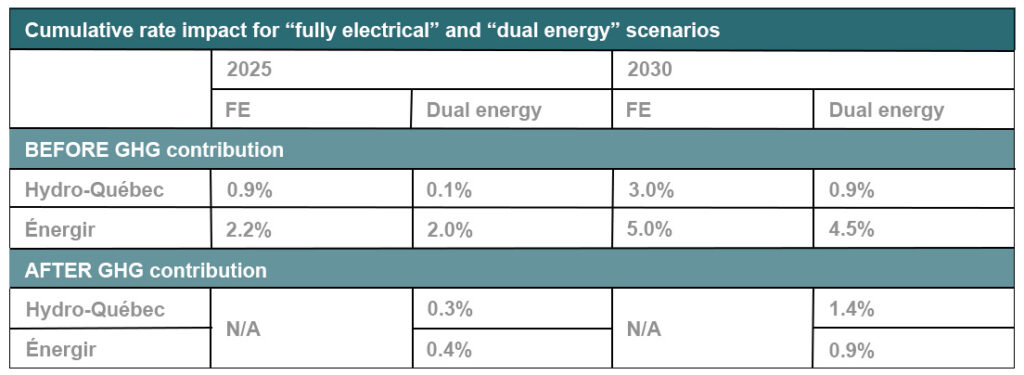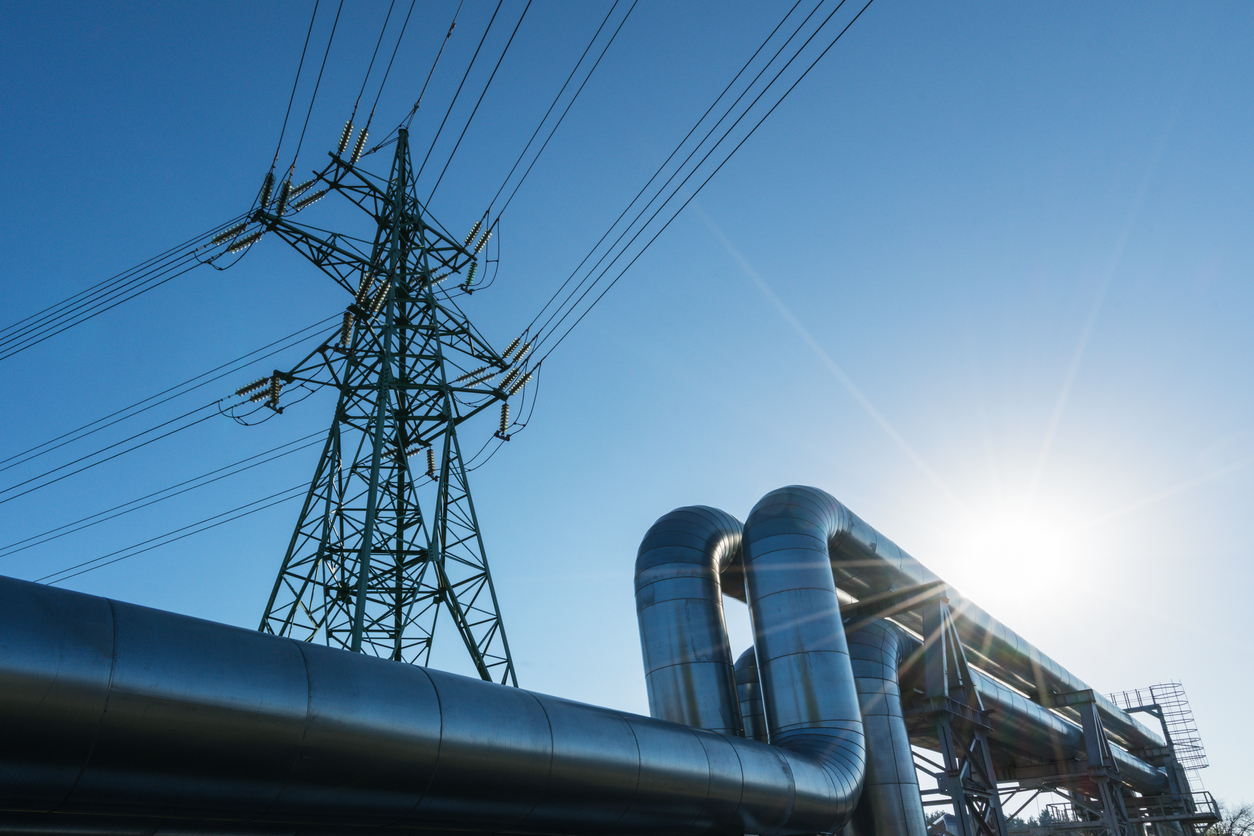Disclosure statement: COPTICOM, who employs the authors, acts as a consultant for Énergir.
Quebec’s energy context
Two companies control almost all electricity and gas infrastructure in Quebec. The Crown corporation Hydro-Québec holds a monopoly on transmitting, distributing and purchasing electricity, and produces or buys over 90% of Quebec’s hydropower. Énergir, meanwhile, distributes 97% of the natural gas used in Quebec. It is 80.9% owned by the Caisse de dépôt et placement du Québec (CDPQ)—managers of Quebec’s pension plan, among other things—and the Fonds de solidarité FTQ, a labour investment fund that manages a part of the retirement savings of around 735,000 workers.
In Quebec, greenhouse gas (GHG) emissions from natural gas are practically all due to the distribution and consumption of gasdelivered by Énergir. The company intends to make its operations carbon‑neutral by 2050 through the development of renewable natural gas (RNG), energy efficiency improvements on the customer end and taking a complementary approach with plans for electrification.[1]
The Quebec government has set a GHG emission reduction goal of a 37.5% decrease by 2030 compared to 1990 levels, and is aiming for carbon neutrality by 2050. It plans to achieve these objectives through major electrification of road transport, building heating and a major proportion of industrial applications.
Residential energy consumption in Quebec
In 2019,[2] natural gas represented only 13% of Quebec’s energy consumption,[3] compared to 36% for Canada as a whole.[4] It is used by industry (55%), institutional and commercial buildings (28%) and residential buildings (11%), with the remainder going to other niche uses (5%). It is nearly unused in producing electricity, 99.6% of which comes from hydroelectricity and wind energy.
Residential energy consumption in Quebec is primarily electricity (74%), in addition to 12% for biofuels, 8% for natural gas and 5% for petroleum products such as oil. The majority of institutional and commercial buildings’ consumption is electricity (53%), followed by natural gas (27%), oil (16%), propane and biofuels (4%). Natural gas consumption in the building and industry sectors resulted in 12 Mt CO2 eq in 2019, or 14.2% of Quebec’s greenhouse gas (GHG) emissions.
Dual energy agreement between Hydro-Quebec and Énergir
On July 13, 2021, Hydro-Québec and Énergir signed a dual energy agreement for 2022–2045. This partnership aims to convert the natural gas heating systems of Énergir customers into systems supplied by both electricity and natural gas. During cold snaps, when heating demand peaks, natural gas will be used in place of electricity, reducing the stress on the Hydro‑Québec network. Outside these peak periods, buildings will be heated by electricity alone. Dual energy is a means of maximizing the role of electricity in building heating—and thereby reducing GHG emissions associated with heating—while minimizing impact during winter peaks.

In Phase 1 of the agreement, around 100,000 residential customers were encouraged to convert to dual energy.[5] In Phase 2, the dual energy offer will be broadened to commercial and institutional sub‑sectors.[6] The Régie de l’énergie should decide on the launch of Phase 2 in spring 2023. Note that the agreement also aims to encourage owners of new residential, commercial and institutional buildings to opt for dual energy heating systems.[7]
The agreement is supported by the government of Quebec, which has signalled to the Régie de l’énergie its desire to encourage the conversion of heating systems to dual energy (electricity and natural gas).[8] The agreement is also clearly aligned with 2023 Plan for a Green Economy and its objective to reduce heating-related emissions to 50% of 1990 levels by the end of the decade.[9]
Any new or existing Énergir customer who wants to convert their heating system to dual energy can benefit from grants[10] covering up to 80% of conversion costs[11] from the government of Quebec and Hydro-Québec.
Dual energy conversion will reduce natural gas consumption by residential, commercial and institutional customers by over 70%,[12] while the electrification of buildings (residential, commercial and institutional) converted to dual energy will require Hydro‑Québec to supply 63 MW of additional power in 2030.[13]
According to Hydro-Québec, implementing dual energy will yield savings of $1.682 billion compared to what full electrification of building heat would cost,[14] in addition to requiring that 2,070 MW of additional capacity be installed by 2030[15] at an estimated cost of $2.7 billion (see table below).

Énergir, for its part, will be given financial compensation (called a GHG contribution)[16] up to a cumulative total of $403 million by 2030[17] for the loss of revenues resulting from some of its customers switching to dual energy, in order to balance the impact on rates for customers of both distributors. This compensation should cover approximately 80% of Énergir’s lost revenue,[18] but depends on the actual quantity of natural gas that will be replaced by Hydro-Québec electricity.

Is dual energy the best way to decarbonize buildings?
At first glance, the dual energy agreement between Hydro-Québec and Énergir is an attractive mechanism for decarbonizing the building sector. It enables better management of peak power demands on the power grid while simultaneously supporting a natural gas distributor in reducing its energy deliveries. It is also more economical for Hydro‑Québec than full electrification of building heating. In short, it enables all the parties involved to successfully reach a series of important economic, technical and climate objectives.
It is also a bold solution, made possible by several mutually reinforcing circumstances. First, it involves two companies with monopoly control that have set sizable decarbonization objectives for themselves. Hydro‑Québec’s shareholder, the government of Quebec, is likewise committed to a decarbonization timeline with milestones in 2030 and 2050, while Énergir’s shareholders, the Caisse de dépôt et placement du Québec and the Fonds FTQ, are purposely working to decarbonize their investment portfolios. Finally, the solution spares the customers of both companies from rate increases, compared to full electrification of building heating.
Furthermore, the dual energy agreement approach ensures that the GHG contribution paid to Énergir by Hydro‑Québec will remain in the public sphere (via the CDPQ) or at least as part of the common good (for the hundreds of thousands of Quebec residents whose retirement savings are partially managed by the Fonds de solidarité FTQ).
Nonetheless, this agreement is not without its limitations. First of all, it applies only to the building sector (responsible for 35.9% of the volume of natural gas distributed). The industrial sector, with 64.1% of the volume distributed, is left out altogether.
The agreement itself also does not include any complementary policies or instruments that might help further decarbonize the building sector and limit peak demand impacts on the power grid.[19] The government has considered or partly deployed such measures, but Hydro-Québec and Énergir have not developed a consistent and integrated approach.[20] With such an approach, it would be possible to assess whether the 30% residual heating demand that Énergir will continue to assume under the agreement could be partially or fully addressed by complementary methods.
The dual energy agreement could also lead to a certain degree of “carbon lock‑in” in Quebec’s building sector. Replacing heating systems at the end of their lifespan and connecting new customers to the Énergir network (and, by extension, the dual energy offer) by 2030 locks in a certain level of natural gas consumption until 2045, due to Énergir’s 15‑year customer contracts. What is even more concerning is that this goes against the recommendations of the International Energy Agency, including the recommendation to ban new fossil fuel boilers starting in 2025 if we want to reach net zero by 2050.[21]
Finally, Énergir hopes to use RNG to replace the remaining 30% natural gas that is necessary under the agreement, in order to reach net zero for the building sector by 2050. At this point, however, there are no indications that RNG will be available in sufficient quantity to fully replace that 30%. In 2022, for example, RNG made up only 0.6% of the natural gas distributed by Énergir.[22]
Is this an innovative model that’s reproducible elsewhere in Canada?
The dual energy agreement between Hydro-Québec and Énergir bolsters the idea that a rapid reduction in the production and consumption of fossil fuels must inevitably call for large-scale systemic efforts, which here are brought about, directly and indirectly, by the action and support of the Quebec government.
The agreement was made within a specific business, regulatory and political context. Both partners’ property is in large part public domain, both were already set on the road to decarbonization, and the government of Quebec has made strong commitments to fight climate change and radically reduce the use of fossil fuels. It is possible that other public utility companies elsewhere in Canada will be inspired to adapt this approach to their own networks.
Overall, with this agreement Hydro-Québec and Énergir, with the support of the government of Quebec, are taking a proactive approach to the energy transition, rather than a passive or reactive one. This may be the one of the most significant lessons to learn from this case study.
References
[1] Énergir, “Climate Resiliency Report 2021,” 2022, pp. 27–29.
[2] As data for 2021 and 2022 are not yet available, we have used 2019 data, given that 2020 was a statistical anomaly due to the COVID-19 pandemic.
[3] Johanne Whitmore and Pierre-Olivier Pineau, “The State of Energy in Quebec,” Chair in Energy Sector Management – HEC Montréal, February 2022, p. 5. The data in this section are drawn primarily from this report.
[4] Canada Energy Regulator, “Provincial and Territorial Energy Profiles – Canada,” July 28, 2022.
[5] Régie de l’énergie du Québec, “Décision – Demande relative aux mesures de soutien à la décarbonation du chauffage des bâtiments – Phase 1 (R-4169-2021),” May 19, 2022, p. 54.
[6] The residential sub‑sector accounts for 41.5% of emissions in Quebec’s building sector in 2019 (3.5 Mt CO2 eq), compared to 58.5% for the commercial and institutional sub-sectors (4.93 Mt CO2 eq).
[7] Régie de l’énergie du Québec, “Décision,” op. cit., p. 59.
[8] Gouvernement du Québec, Order in Council 1395-2022; Order in Council 874-2021.
[9] Gouvernement du Québec, “2023 Plan for a Green Economy – Framework Policy on Electrificiation and the Fight Against Climate Change,” Québec, Gouvernement du Québec, November 2020, p. 6.
[10] Régie de l’énergie du Québec, « Décision », op. cit., p. 78.
[11] Ibid.
[12] Ibid, p. 117.
[13] Hydro-Québec, “Offre d’Hydro-Québec Distribution et d’Énergir en réponse aux objectifs de décarbonation du chauffage des bâtiments énoncés dans le Plan pour une économie verte 2030 (R-4169-2021),” p. 21.
[14] Régie de l’énergie du Québec, « Décision », op. cit., p. 51.
[15] By comparison, the total hydroelectric capacity installed in Quebec in 2019 was 40,850 MW and provided 94% of electricity for the province. Canada Energy Regulator, “Provincial and Territorial Energy Profiles – Québec ».
[16] Régie de l’énergie du Québec, “Décision”, op. cit., p. 11.
[17] The maximum compensation of $403 million will be paid out if all the agreement’s target customers choose to convert to dual energy. Hydro‑Québec and Énergir. “Réponse des distributeurs à l’engagement numéro 2 (R-4169-2021),” February 24, 2022, p. 4.
[18] Régie de l’énergie du Québec, « Décision », op. cit., p. 124.
[19] In the “fully electrical” (FE) scenario, at peak times, the entire heating load is borne by electrical resistance, and there is no value added by efficient equipment. In this context, the outcome is that both scenarios rest on theoretical extremes (total electrification on one side, and complementarity between natural gas and electricity on the other) that make no effort to take into account other solutions, such as those mentioned in note 21. Hydro-Québec and Énergir, “Réponse des distributeurs à la demande de renseignements n° 1 de l’AHQ-ARQ,” December 8, 2021, p. 12.
[20] Here we are thinking of dynamic pricing or smart energy technology, energy efficiency improvements through more widespread use of heat pumps, heat accumulators or thermal insulation of buildings, the promotion of low‑carbon measures based on behavioural changes, or potential electricity interties. In the hearing before the Régie de l’énergie on February 21, 2022, Hydro‑Québec suggested that complementary measures would be rolled out over the coming years in order to reach net zero by 2050. However, there is no evidence that this involves an integrated process, and only the replacement of natural gas by RNG was mentioned, without any consideration of whether there would be enough RNG available to replace the 30% of natural gas needed in a system converted to dual energy. Régie de l’énergie du Québec, “HQD-Énergir – Demande relative aux mesures de soutien à la décarbonation du chauffage des bâtiments – Audience du 21 février 2022 (R-4169-2021),” Régie de l’énergie du Québec, February 21, 2022, p. 73.
[21] International Energy Agency, « Net Zero by 2050 – A Roadmap for the Global Energy Sector », International Energy Agency, mai 2021, p. 19.
[22] Johanne Whitmore and Pierre-Olivier Pineau, “The State of Energy in Quebec 2022,” op. cit., p. 32.


